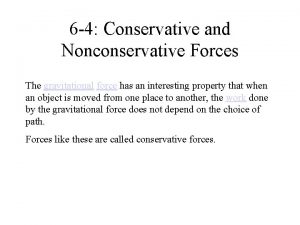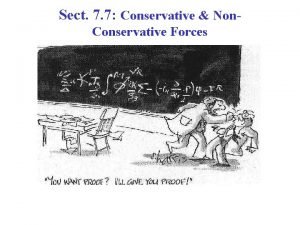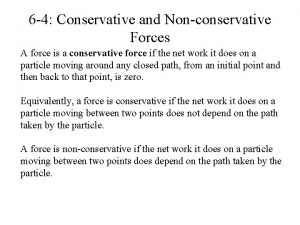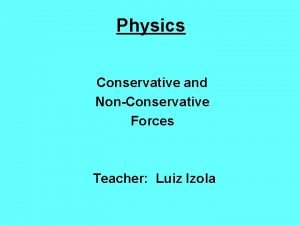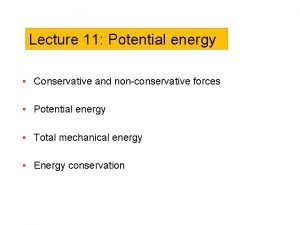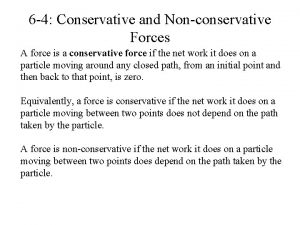Unit 3 Lesson 3 Conservative and NonConservative Forces









- Slides: 9

Unit 3, Lesson 3: Conservative and Non-Conservative Forces

Conservative Forces: – The work done in moving something from A to B is not dependant on the path. E. g. » Gravity » Electrostatic Force » Elastic Force

Non-Conservative Forces: – The work done moving something from A to B depends on the path taken. E. g. • Friction • Air resistance • Work done against a non-conservative force is converted to other forms of energy, such as heat and sound. • Work done against a conservative force is stored as potential energy.

Conservation of Energy: – If there are no non-conservative forces: PE 1 + KE 1 = PE 2 + KE 2 – With non-conservative forces: • W’ = work done by the nonconservative force • W’ = ΔE = ΔPE + ΔKE • PE 1 + KE 1 + W’ = PE 2 +KE 2

Example: Bri skis down a 30°slope starting from rest. After she has lost 200 m in elevation, her speed is 150 km/h. If her mass is 60 kg, find: a) The work done by friction and air resistance (W 1) b) The average resistance force. d = 400 m 200 m 30° Note: 150 km/h = 41. 67 m/s

Note: 150 km/h = 41. 67 m/s d = 400 m 200 m 30° Energy before + Work(-) = Energy after mgh + W’ = ½mv 2 a) W’ = ½mv 2 – mgh = ½ (60)(41. 67)2 – (60)(9. 8)(200) = 52, 100 – 117, 600 = -65, 500 J b) W’ = F • d -65, 500 = - F (400) F = 160 N

Varying Forces F d W=F • d= area under F vs. d graph F d

Example: Loyally defending his friend Hannah, Logan fires a 10 g bullet through a 60 cm long gun barrel. F(N) Using the graph, find: 1500 N a) The work done on the bullet. b) The velocity of the bullet 20 40 60 d(cm) as it exits the gun. a) W = area = 0. 4 m • 1500 N = 600 J Note: distance must be in meters b) W = ΔKE 600 = ½ (0. 01)v 2 v = 350 m/s

Recommended Questions: • Energy Practice Problems #1, 3, 8 -10, 14 -17, and 19 -20
 Is gravitational force conservative or non-conservative why
Is gravitational force conservative or non-conservative why Conservative and non conservative forces
Conservative and non conservative forces Force conservative et non conservative
Force conservative et non conservative Force conservative et non conservative
Force conservative et non conservative Physics 03-06 impulse and momentum answer key
Physics 03-06 impulse and momentum answer key Conservative forces
Conservative forces Parallel force formula
Parallel force formula Contact force
Contact force Balanced forces and unbalanced forces venn diagram
Balanced forces and unbalanced forces venn diagram Destructive process examples
Destructive process examples
